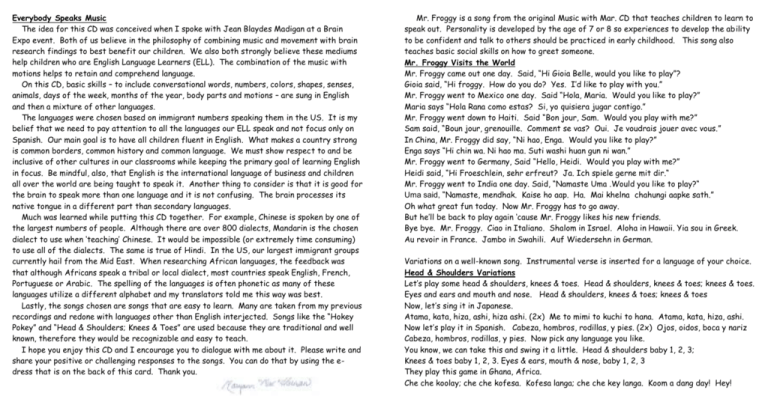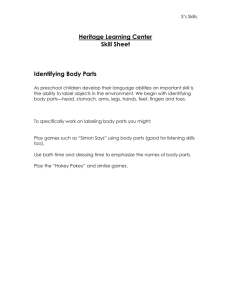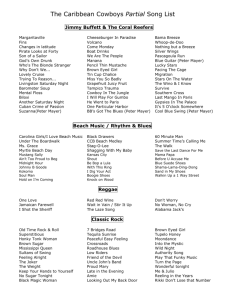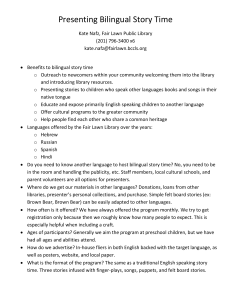Everybody Speaks Music - Music with Mar. Is
advertisement

Everybody Speaks Music The idea for this CD was conceived when I spoke with Jean Blaydes Madigan at a Brain Expo event. Both of us believe in the philosophy of combining music and movement with brain research findings to best benefit our children. We also both strongly believe these mediums help children who are English Language Learners (ELL). The combination of the music with motions helps to retain and comprehend language. On this CD, basic skills – to include conversational words, numbers, colors, shapes, senses, animals, days of the week, months of the year, body parts and motions – are sung in English and then a mixture of other languages. The languages were chosen based on immigrant numbers speaking them in the US. It is my belief that we need to pay attention to all the languages our ELL speak and not focus only on Spanish. Our main goal is to have all children fluent in English. What makes a country strong is common borders, common history and common language. We must show respect to and be inclusive of other cultures in our classrooms while keeping the primary goal of learning English in focus. Be mindful, also, that English is the international language of business and children all over the world are being taught to speak it. Another thing to consider is that it is good for the brain to speak more than one language and it is not confusing. The brain processes its native tongue in a different part than secondary languages. Much was learned while putting this CD together. For example, Chinese is spoken by one of the largest numbers of people. Although there are over 800 dialects, Mandarin is the chosen dialect to use when ‘teaching’ Chinese. It would be impossible (or extremely time consuming) to use all of the dialects. The same is true of Hindi. In the US, our largest immigrant groups currently hail from the Mid East. When researching African languages, the feedback was that although Africans speak a tribal or local dialect, most countries speak English, French, Portuguese or Arabic. The spelling of the languages is often phonetic as many of these languages utilize a different alphabet and my translators told me this way was best. Lastly, the songs chosen are songs that are easy to learn. Many are taken from my previous recordings and redone with languages other than English interjected. Songs like the “Hokey Pokey” and “Head & Shoulders; Knees & Toes” are used because they are traditional and well known, therefore they would be recognizable and easy to teach. I hope you enjoy this CD and I encourage you to dialogue with me about it. Please write and share your positive or challenging responses to the songs. You can do that by using the edress that is on the back of this card. Thank you. Mr. Froggy is a song from the original Music with Mar. CD that teaches children to learn to speak out. Personality is developed by the age of 7 or 8 so experiences to develop the ability to be confident and talk to others should be practiced in early childhood. This song also teaches basic social skills on how to greet someone. Mr. Froggy Visits the World Mr. Froggy came out one day. Said, “Hi Gioia Belle, would you like to play”? Gioia said, “Hi froggy. How do you do? Yes. I’d like to play with you.” Mr. Froggy went to Mexico one day. Said “Hola, Maria. Would you like to play?” Maria says “Hola Rana como estas? Si, yo quisiera jugar contigo.” Mr. Froggy went down to Haiti. Said “Bon jour, Sam. Would you play with me?” Sam said, “Boun jour, grenouille. Comment se vas? Oui. Je voudrais jouer avec vous.” In China, Mr. Froggy did say, “Ni hao, Enga. Would you like to play?” Enga says “Hi chin wa. Ni hao ma. Suti washi huan gun ni wan.” Mr. Froggy went to Germany, Said “Hello, Heidi. Would you play with me?” Heidi said, “Hi Froeschlein, sehr erfreut? Ja. Ich spiele gerne mit dir.“ Mr. Froggy went to India one day. Said, “Namaste Uma .Would you like to play?“ Uma said, “Namaste, mendhak. Kaise ho aap. Ha. Mai khelna chahungi aapke sath.” Oh what great fun today. Now Mr. Froggy has to go away. But he’ll be back to play again ‘cause Mr. Froggy likes his new friends. Bye bye. Mr. Froggy. Ciao in Italiano. Shalom in Israel. Aloha in Hawaii. Yia sou in Greek. Au revoir in France. Jambo in Swahili. Auf Wiedersehn in German. Variations on a well-known song. Instrumental verse is inserted for a language of your choice. Head & Shoulders Variations Let’s play some head & shoulders, knees & toes. Head & shoulders, knees & toes; knees & toes. Eyes and ears and mouth and nose. Head & shoulders, knees & toes; knees & toes Now, let’s sing it in Japanese. Atama, kata, hiza, ashi, hiza ashi. (2x) Me to mimi to kuchi to hana. Atama, kata, hiza, ashi. Now let’s play it in Spanish. Cabeza, hombros, rodillas, y pies. (2x) Ojos, oidos, boca y nariz Cabeza, hombros, rodillas, y pies. Now pick any language you like. You know, we can take this and swing it a little. Head & shoulders baby 1, 2, 3; Knees & toes baby 1, 2, 3. Eyes & ears, mouth & nose, baby 1, 2, 3 They play this game in Ghana, Africa. Che che koolay; che che kofesa. Kofesa langa; che che key langa. Koom a dang day! Hey! This is one of the most popular songs on my CDs. The basic concept is numbers up to five. When pulling fingers out, you are saying the number word in English and giving a visual representation of the amount the number represents. In this version, the number word is inserted in various languages. At the bottom of these lyrics, is a list of number words to five in several languages that were used or could be used. Children love this song because there is the safety of all the fingers always coming back at the end. Teaches constancy. Five Fingers in My Pocket I’ve got five fingers in my pocket. Five fingers hidden away Five fingers in my pocket. Look! Aw, one went away! I’ve got four fingers in my pocket. Four fingers hidden away Four fingers in my pocket. Look! Aw, one went away! Repeat for three, two and one. . . I’ve got no fingers in my pocket. No fingers hidden away No fingers in my pocket. Look! Five fingers back to stay. Hurray! Inserted languages Spanish cinco, quartro, tres, does, uno Japanese go, shi, san, ni, ichi Greek bende, dessera, drio, dio, ena Farsi shesh, chanj, chahar, she, doh, yek Estoy muy triste. (I am sad). Here are two versions of this counting song. One using sign language at the end and the other counting backwards (which wires the brain for subtraction). I Can Count to Ten (Spanish, Japanese, Farsi, Chinese) I can count to ten and you can count to ten and if we count to ten one time, we can do it again! 1, 2, 3, 4, 5, 6, 7, 8, 9, 10! Counting with my friend! I can count in Espanol. That’s Spanish. Uno, dos, tres, cuatro, cinco, seis, siete, ocho, nueve, dies Obachon, that’s grandmother, taught me to count in Japanese Ichi, ni, san, shi, go, ruko, sichi, hachi, ku, Ju My family comes from Iran. I can count in Farsi. Yek, do, she, chahar, tanj, shesh, haft, hasht, noh, dah Here’s a way to count in Chinese. ee, ar, san, suh, eu, lao, chi, bah, chio, ser I can count to ten……..This time when we count, let’s count on one hand. That way all our friends who can’t hear will understand 1,2,3 etc I Can Count to Ten (Tagalog, German, Hindi, French) I can count to ten and you can count to ten and if we count to ten one time, we can do it again! 1, 2, 3, 4, 5, 6, 7, 8, 9, 10! Counting with my friend! In the Phillipines, they count in Tagalo Isa, dalawa, apat, tatlo, lima, anim, pito, walo, siyam, sampu, Freyda counts in German eins, zwei, drei, vier, funf, sechs, sieben, acht, neun, zehn My name is Raj, and in India, we count in Hindi Ek, do, tin, char, panch, che, saant, aanth, nou, dus In France, we count en France. Un, deux, trios, quatre, cinq, six, sept, huit, neuf, dix I can count to ten; and you can count to ten. If we count to ten one time, we can do it again. This time when we count, this is what we’ll do. We will show that we can count backwards, too! 10,9,8-7,6,5-4,3,2-1 Counting sure is fun! In this song, we sing first primary colors and then secondary colors. Each version uses three languages along with English. It is recommended that visuals are used to show the colors. This would be helpful because it gives a physical representation of the color. Colors (Italian, French, Spanish) Primary colors 1, 2, 3. Can you say their names with me? Red (Roso), Yellow (Giallo), Blue (Azurro) in Italiano, molto bono! Secondary colors 1, 2, 3. Can you say their names with me? Orange (Orange), Purple (Violette), Green (Verde). In Italiano, molto bono! Primary colors 1, 2, 3. Can you say their names with me? Red (Rouge), Yellow (Jaune), Blue (Bleu) En France, ce bon! Secondary colors 1, 2, 3. Can you say their names with me? Orange (Orange), Purple (Mov), Green (Vert). En France, ce bon! Primary colors 1, 2, 3. Once more say their names with me. Red (Rojo), Yellow (Amarillo), Blue (Azul) In Espanol, hecho bueno! Secondary colors 1, 2, 3. Once more say their names with me. Orange (Anaranjado), Purple (Purpura), Green (Verde). In Espanol, hecho bueno! Primary and secondary colors, too. You know them all. Yes. You do. Colors (Hindi, Chinese, German) Primary colors 1, 2, 3. Can you say their names with me? Red (Lahl), Yellow (Nela), Blue (Pila). In Hindi, bakoo! Secondary colors 1, 2, 3. Can you say their names with me? Orange (kasahree), Purple (chamani), Green (harah). In Hindi, badache! Primary colors 1, 2, 3. Can you say their names with me? Red (honzir), Yellow (fansir), Blue (lansir) In Chinese, hapongo! Secondary colors 1, 2, 3. Can you say their names with me? Orange (tresir), Purple (tusir), Green (nisir). Hapongo! Primary colors 1, 2, 3. Once more say their names with me. Red (Rot), Yellow (Gelb), Blue (Blau) In German, ser gut! Secondary colors 1, 2, 3. Once more say their names with me. Orange (Orange), Purple (Violett), Green (Grun). In Deutsch, ser gut! Primary and secondary colors, too, you know them all. Yes. You do This is a variation of the “Today is Monday” song. It can be done using a book or visuals that have the days of the week on them. Children should see words spelled in the different languages. You can add other languages. Today is Monday Everywhere Today is Monday. Today is Monday. In Spanish that is Lunes, In Hindi, Somvar. In French, Lundi. And in Japanese, Getsuyubi. Today is Tuesday. Today is Tuesday. In Spanish that is Martes. In Hindi Mangalwar. In French Mardi. And in Japanese, Kayoubi. Today is Wednesday. Today is Wednesday. In Spanish that is Mercredi. In Hindi, Budhvar. In French, Mercredi. And in Japanese, Suiyoubi. Today is Thursday. Today is Thursday. In Spanish that is Jueves. In Hindi, Burhaspativas. In French, Jeudi. And in Japanese, Mokuyoubi. Today is Friday. Today is Friday. In Spanish that’s Viernes. In Hindi, Shukravas. In French, Vendredi. And in Japanese, Kinyoubi. Today is Saturday. Today is Saturday. In Spanish that is Sabado. In Hindi, Shaniva. In French, Samedi. And in Japanese, Doyoubi. Today is Sunday. Today is Sunday. In Spanish that’s Domingo. In Hindi, Raviva. In French, Dimanche. And in Japanese, Nichiyoubi. Those are the days! This song works on the basic movement skills. Many languages do not differentiate between hop, skip, or jump. When working on these skills, keep the following in mind: bounce – your feet stay on the ground; jump – two feet leave the ground; hop – one foot leaves the ground; and skip – alternating feet leave the ground. This is in order of difficulty. Being able to skip indicates reading readiness. We Walk We walk. We walk. We walk and walk and walk. We hop. We hop. We hop, hop, hop. We skip. We skip. We skip and skip and skip. We stop. We stop. We stop, stop, stop. We jump. We jump. We jump and jump and jump. We run. We run. We run, run, run. We bounce. We bounce. We bounce and bounce and bounce. We sit. We sit because we’re done! Spanish French walk Caminamos Nous marchons hop Brincamos Nous sautons a choche-pied skip Saltamos Nous sautons stop Paramos Nous arretons jump Saltamos Nous sautons run Corremos Nous courons bounce Despedimos Nous rebondissons sit Sentamos Porque terminamos Nous asseyons sommes finis This song is repeated four times. Once in English and then three more times with the following languages. Point to your body parts as you sing. Five Senses Spanish French Chinese I have two ears to hear oidos oreilles arh too-o I have two eyes to see ojos yeux en ching I have a mouth to taste boca bouche tsway pah To smell there’s a nose on me nariz nez bee tzuh With my sense of touch tacto contact mo I get a hug from you abrazo etreinte chin ee shah And that is what my five senses do! What a wonderful way to learn direction! Also good patterning for Math. Hokey Pokey You put your right arm in. You take your right arm out. You put your right arm in and shake it all about. You do the hokey pokey and turn yourself around. That’s what it’s all about. Repeat with left arm. You put your right leg in. You take your right leg out. You put your right leg in and shake it all about. You do the hokey pokey and turn yourself around. That’s what it’s all about. Repeat with left leg. You put your head in. You take your head out. You put your head in and shake it all about. You do the hokey pokey and turn yourself around. That’s what it’s all about. You put your whole self in. You take your whole self out. You put your whole self in and shake it all about. You do the hokey pokey and turn yourself around. That’s what it’s all about Hokey Pokey Spanish Pon tu brazo derecho adentro. Pon tu brazo derecho afuera. Pon tu brazo derecho adentro y muevelo. You do the hokey pokey y da una vuelta. De eso se trata! Pon tu brazo izquierdo adentro. Pon tu brazo izquierdo afuera. Pon tu brazo izquierdo adentro y muevelo. You do the hokey pokey y da una vuelta. De eso se trata! Pon tu pierna derecha adentro. Pon tu pierna derecha afuera. Pon tu pierna derecha adentro y muevelo. You do the hokey pokey y da una vuelta. De eso se trata! Pon tu pierna izquierda adentro. Pon tu pierna izquierdo afuera. Pon tu pierna izquierda adentro y muevelo. You do the hokey pokey y da una vuelta. De eso se trata! Pon tu cabeza adentro. Pon tu cabeza afuera. Pon tu cabeza adentro y muevelo. You do the hokey pokey y da una vuelta. De eso se trata! Pon tu cuerpo entero adentro. Pon tu cuerpo entero afuera. Pon tu cuerpo entero adentro y muevelo. You do the hokey pokey y da una vuelta. De eso se trata! Hokey Pokey Farsi Daste rast bezar too. Daste rast bezar bedoon. Daste rast bezar too. Belarzoon. You do the hokey pokey. Beecharck. En hamash hamine. Daste chap bezar too. Daste chap bezar bedoon. Daste chap bezar too. Belarzoon. You do the hokey pokey. Beecharck. En hamash hamine. Pawte raste bezar too. Pawte raste bezar bedoon. Pawte raste bezar too. Belarzoon. You do the hokey pokey and beecharck. En hamash hamine. Pawte chap bezar too. Pawte chap bezar bedeoon. Pawte chap bezar too. Belarzoon. You do the hokey pokey. Beecharck. En hamash hamine. Sare bezar too. Sare bezar bedoon. Sare bezar too. Belarzoon. You do the hokey pokey. Beecharck. En hamash hamine. Tannet bezar too. Tannet bezar bedoon. Tannet bezar too. Belarzoon. You do the hokey pokey. Beecharck. En hamash hamine. In Japan, the months are now referred to by their number. For example, the first month is ichi-gatsu. The names used in this song are the old traditional names often still used in Japanese poetry or novels. Their meanings are more poetic, like “The first month the breezes blow”. Have children skip in circle. When naming first six months, walk inward holding hands up. When naming second set, hands down walk out of circle. One step for each month. The Calendar Polka Let’s all do the calendar polka. Let’s name the months of the year We’ll say all twelve and when we’re finished, we’ll give ourselves a cheer January, February, March, April, May, June, July, August, September, October, November, December. That’s the tune! Whew! Let’s sing the months in Spanish and give ourselves a cheer. Enero, Febrero, Marzo, Abril, Mayo, Junio. Julio, Augosto, Septiembre, Octubre, Noviembre, Deciembre. Let’s sing the months in French and give ourselves a cheer. Janvier, Fevrier, Mars, Avril, Mai, Juin, Juillet, Aout, Septembre, Octobre, Novembre, Decembre. Let’s sing the months in Japanese and give ourselves a cheer. Mutsuki, Kisaragi, Yayoi, Uzuki, Satsuki, Minazuki, Fumizuki, Hazuki, Nagatsuki, Kannazuki, Shimotsuki, Shiwasu. The calendar polka! No matter where you go in the world, people get together for food and music. Everyone enjoys sharing their culture. It’s a beautiful thing! This song celebrates that diversity. As each food is sung, music from that culture is played. During the instrumental, all the sounds are played together. These instruments are usually not played together, yet they blended well, just as we people do. After listening, ask children who eats some of the foods heard in the song. Ask them to add other foods their families eat. (Can lead to Math graphing.) Multi-cultural Feast My friends don’t always eat the things I do; Some eat foods I don’t know. I like to try these different foods when to my friends I go. When I go to Jose’s, its arroz con pollo. Platanos. Que Bien! I want to go back again. Oh! (chorus) When I go to Gioia’s, its cacciatore or spaghetti. Her mom says “Buon Appetito!” Then we know its ready. (chorus) Chorizo in Portugal. Couscous in the Mid East. Or you can have poi at a polynesian feast! Kimchee in Korea. Goulash in Hungary. But no matter where you go every place has a Mickey D! My friends don’t always eat the things I do. We try each other’s foods at least. And when my friends and I get together, its a multi-cultural feast! This song is a round. First, the melody is sung in solfege. That is the syllables universally used by musicians to denote pitch. (Everyone DOES speak music!). The song is then repeated in English, Spanish and Hebrew. After that, it is done as a round. Divide the class into groups and have them each pick a part. Great for building listening skills! (Usually successful age 8+) Sing With Me (Solfege)Do, Sol, Re, Mi, Re, Do, Sol, Do. Do, Do, Do, Re, Mi, Sol, Fa, Mi, Mi Sol, Sol, Ti, Do, Re, Mi, Re, Do, Sol. Do, Do, Sol, Sol, Mi, Fa, Mi, Do Sing with me and I’ll sing with you ‘cause singing is such fun to do La, la, la, la, la, la, la, la, la. Singing us such fun to do. (Spanish) Canta conmigo y cantare contigo. Cantar es divertido La, la, la, la, la, la, la, la, la. Cantar es divertido (Hebrew) Zamer emi, vazamerha emcha. Ki shira zo he orah vesimecha La, la, la, la, la, la, la, la, la. Ki shira zo he orah vesimecha We Know Our Shapes We know our shapes so here’s what we’ll do. We’ll draw our shapes and sing them, too. A circle has one line, one line that’s round; start at the top and make this sound. Woo op! Woo oop! One round line. Shapes! Shapes! A square has four sides that are all the same. Say this sound four times to play this game. Wo wo wo wo. Four same sides on a square. Shapes! Shapes! A rectangle has four sides like a square, two are short; two are long. Draw them in the air. Wo woo Wo woo. Two long; two short. Rectangle. Shapes! Shapes! A triangle is different. Its sides are three. Draw three sides and make this sound with me. Ting. Ting. Ting. Triangle has three sides. Shapes! Shapes~ Circle Square Rectangle Triangle Spanish Circulo cuadrado rectangulo triangulo Chinese tsoo jow shi’in you en shi’in tang fon shi’in san chow shi’in Hindi gol choros chokon trikon (ee) We know our shapes. Yes we do. We can draw and sing them, too! Manners Matter Manners matter they really do. Like a mirror they reflect on you. So use your manners everyday, no matter where you work or play. When you meet someone you say “How do you do?” In Spain, “Como estas?”. In China, “Ni hao wan.” In France, “Comment se vas?” When you want something you say “Please”. In Spain, “por favor”, In China, “Chi’in”. In France, “si vous plait” When you get something you say “Thank you” In Spain, “gracias”. In China “Shi shi nee” In France, “merci” In Hindi, thank you’s “Tun ya vad”. In Japanese, “Duomo” In Farsi, “Mamood”. You’re welcome, “Da nada” in Spanish. In Japanese, “Dou itashimashite”. In French, “Je vous en prie”. In Farsi, “Hahesh minkonam”. Animals on My Fingers Four animals on my fingers. Four animals you can see. Four animals on my fingers. Name them with me. Dog. Cat. Bird. Horse. Now say the animals you see in Spanish with me. Perro. Gato. Pajaro Caballo. Now say the animals you see in French with me. Chien. Chat. Oiseau. Cheval. Now say the animals you see, in Japanese with me. Inu. Neko. Tori. Uma. This song helps children learn direction by repeating the command 3 times. With the teacher up front doing it, ELL can be successful! By watching the teacher as well as the other students, ELL can do what the song says. Another interesting lesson to teach, is to put the song on in one of the languages other than English and ask your English speaking students to ‘do it’. If they’ve never heard the song before, they won’t know what is being said. This allows them to ‘experience’ what an ELL feels like. Hey Hey Everybody Hey hey everybody lift your arms (3X) And smile a smile for me. Hey hey everybody lift your arms. Turn around (3X) And smile a smile for me. Hey hey everybody lift your arms. Turn around, stamp your foot. And smile a smile for me. Hey hey everybody lift your arms.Turn around, stamp your foot. Get down stand up (3X) Hey hey everybody lift your arms. Turn around, stamp your foot. Get down stand up, Make a silly sound (3X) And, smile a smile for me. Hey, Hey Everybody! (Spanish) Hey Hey todos, levanten los brazos. Y sonrie para mi. Hey Hey todos levanten los brazos, una vuelta. Y sonrie para mi. Hey Hey todos levanten los brazos, una vuelta, pisen los pies. Y sonrie para mi. Hey Hey todos levanten los brazos, una vuelta, pisen los pies, bajen para abajo, suban para arriba. Y sonrie para mi. Hey Hey todos levanten los brazos, una vuelta, pisen los pies, bajen para abajo, suban para arriba, hagan un sonido tonto. Y sonrie para mi. Hey, Hey Everybody! (Hebrew) Shalom lekolam, harimu et hayadiem. Chayech eleye. Shalom lekolam, harimu et hayadiem, histovevu. Chayech eleye. Shalom lekolam, harimu et hayadiem, histovevu, ler koa baragliem. Chayech eleye. Shalom lekolam, harimu et hayadiem, histovevu, ler koa baragliem, laredet lemata lacum, Chayech eleye Shalom lekolam, haremu et hayadiem, histovevu, ler koa baragliem, laredet lemata lacum, taa sou kol matzchik. Chayech eleye. This song can be done in sign language. The sign language document can be obtained by emailing me. Ask children if they know other ways to say “I love you”. Write the different ways up on the board so they can see. How Many Ways Can You Say ‘I Love You’? How many ways can you say “I love you”? How many ways can you say “I care”? How many ways can you say “I love you”? People say it everywhere. In Germany “Ich liebe dich”; In Spain “Te amo”; In China “Wo ai ni”; In Italy “Tu voglio” We learn to speak in other languages to say hello and goodbye Its time we learn to say I love you. Come on let’s try. In Israel “Oni ohev otoch”; In Japan “Anata o aishite imasu”. In Norway “Jeg esker deg”; In France “Je Taime”. How many ways can you say “I love you”? How many ways can you say “I care”? How many ways can you say “I love you”? People say it everywhere. And it’s nice to know you care. I love you! This following song is a song of celebration from Nigeria that is usually sung with the words “Everybody loves Saturday night.” It was a celebratory song when they won their freedom from being a Colony. I have given it a Christmas twist. The words “Christmas Time” and not “Christmas” are used because, although not everyone celebrates Christmas, most people love the spirit of the whole season. Everybody Loves Christmas Time Everybody loves Christmas Time. (2x) Everybody, everybody, everybody, everybody. Everybody loves Christmas Time. Nigerian - Bobo waro fero kerisimisi (2x) Bobo waro. Bobo waro. Bobo waro. Bobo waro. Bobo waro fero kerisimisi Spanish - Todos ama tiempo de la Navidad (2x) Todos. Todos. Todos. Todos. Todos ama tiempo de la Navidad. Chinese - Ren ren si huan sing tan cheh. (2x) Ren ren si. Ren ren si. Ren ren si. Ren ren si. Ren ren si huan sing tan cheh Italian - Tutti ama il tempo di Natale (2x) Tutti. Tutti. Tutti. Tutti.. Tutti ama il tempo di Natale. French - Tout le monde aime le temps de Noël. (2x) Tout le monde. (4x) Tout lemonde aime le temps de Noel. This is a medley I wrote for my senior year recital when getting my BA in Music Education. It was a tribute to all the ways people sing to their children as they rock them to sleep. It was a song I sang to Gioia every night. Little Lullabies with Love Hushabye, Don’t you cry. Go to sleep little baby. When you wake you shall find all the pretty little horses. Blacks and bays; dapples and grays. Coach and six a little horses. A la ruru nino. A la ruru ya. Duermite mi nino. Y duermiete ya. Hush my little baby. Close your weary eyes. I will sing a song for you. Lulla lulla lullaby. Fa la nana bambin. Fa la nana bambin. Nei brazeti, de la mama. Nei brazeti de la mama. Fa la nina, fa la la la la. Go to sleep. Go to sleep. Go to sleep now. Gute nacht. Gute nacht mein feines lieb. Gute nacht schlaf wohl mein kind. (2x) Das ich die engel huten all. Die in dem schoenen himmel sind. Gute nacht. Gute nacht mein feines lieb. Gute nacht schlaf wohl mein kind Let children get partners to hand jive with. Allow them to set their own pattern for the chorus part of song. When it gets to the part where languages are said, have them keep a light beat on their thighs and repeat the words. Go back to hand jive when chorus comes back. Children can add other languages. Goodbye to You Goodbye to you my little friend. Goodbye to you. I’ll see you again. It doesn’t matter where you’re from. Let’s sing goodbye to everyone. You take your little hand wave bye, bye, bye. In Spanish, “Adios”. In Vietnamese “Chio”(Jow). In French,“Au Revoir”. In Greek,“Gia Sou” In Japanese, “Soyanara”; In Indian, “Al Vida”; In German, “Auf wiedersehn” In Hebrew,“Lehit Raot”; In Italian, “Arriverderci” . In Arabic, “Maa Essaalama”; In Ibo Nigerian, “Ganu”; In Portugese, “Ate lago”. Credits All songs written or adapted by Mar. Harman Performed by Mar. Harman Produced by Music with Mar. Arrangements & instrumentation by Mark J. Dye Background vocals: Mark J. Dye, Gioia Harman, Enga Gilday, Rajashree Limaye, Stacy Jackson, Jeremy Ragackous, Sara Pierce, Stefanie & Evan Miller, Samantha West, Caitlyn, Ally & Joey Russo, Robin LeVine, Chancellor Hoffmann, Jessica Howell, Enga Gilday Artwork by Ashley Montan Reproduced by CD Centric Copyright Maryann Harman 2008 Many of these songs were performed by children on my first CD. They have gone on to become musicians, performers, parents and teachers. I am proud of each and everyone of them and grateful they are a part of my life. Thank you to Mark who always makes my ideas ‘work’; to Jean Blaydes Madigan for the ‘idea’; to Ashley Montan for artwork help and Spanish translations; Rajashree for help with Hindi; Enga for help with Chinese and Naz for her help with Farsi. And to all others who inspired me and helped me along the way. This was fun! Write to Mar. : mar@musicwithmar.com







